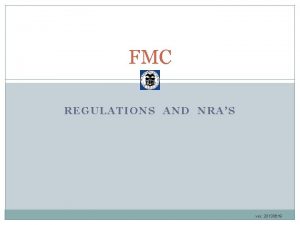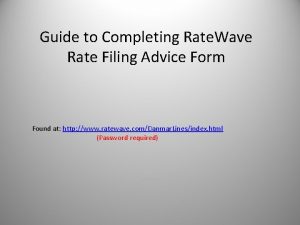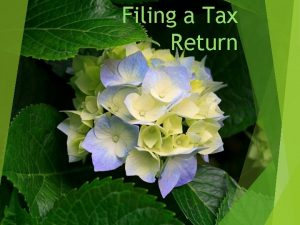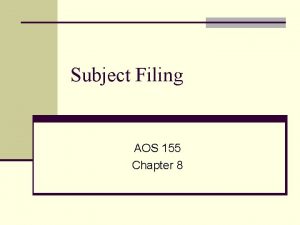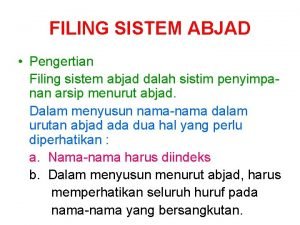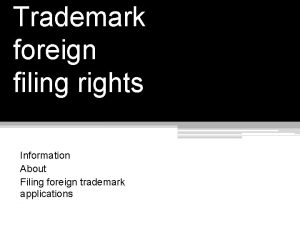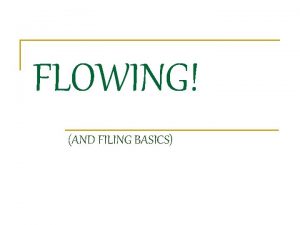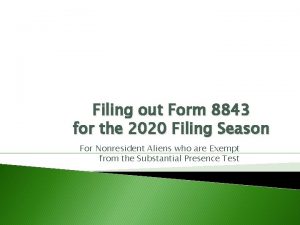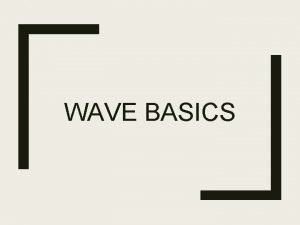Guide to Completing Rate Wave Rate Filing Advice














- Slides: 14

Guide to Completing Rate. Wave Rate Filing Advice Form Found at: http: //www. ratewave. com/Danmar. Lines/index. html (Password required)

Part 1 : General Filing Information **Please use the “How to Check Existing Tariff Rates” hyperlink on the bottom of the Danmar main page; this will take you to a Powerpoint explaining how to use our website to check for existing commodities/rates** If you select New, Rate. Wave will always check to make certain rate is really new. If rate already exists, there is no charge for sending duplicate filing instructions. Complete this ONLY if you are amending an existing rate AND only after you have already checked the electronic Tariff section to identify exactly which rate you wish to amend. Please see “How To Check Existing Tariff Rates” Power. Point for further instructions on how to do this. At the top left hand side of each Rate. Wave page you will see a 10 digit number, please enter that here (6 numbers in the first box, 4 in the second. ) If you made a filing and then realize on the same day that you made a mistake or omitted information, please select this box to let Rate. Wave know so that we will not file incorrect information.

Part 1 (Cont’d): General Filing Information < How Danzas Identifies the Branch/Company < Danzas 3 -letter unique office code Please provide us with all information, in case Rate. Wave has any questions about your filing Using an expiration date is highly recommended. 30 -90 days is recommended for All-Inclusive Rates, so that if the underlying Steamship Line’s additional charges are increased, you may not have to wait a full 30 days to make your rate increase effective. At the very least, if a rate is based on a Buy Rate in a Service Contract, make your Expiration Date match the Expiration Date of the Service Contract.

Part 2: Commodity Information (1) (2) (1) Harmonized Code Number: If you wish, you can use this box to provide Rate. Wave with the Harmonized Code Number. Please remember that you MUST provide us with a commodity description or part of a commodity description; The Harmonized Code number will be used as a reference point ONLY for Rate. Wave. (2) Schedule B Number: If you wish, you can use this box to provide Rate. Wave with the Schedule B Number. As above, please remember that you MUST provide us with a commodity description or part of a commodity description; The Schedule B number will be used as a reference point ONLY for Rate. Wave.

Part 2 (Cont’d): Commodity Information Commodity Description: Please make the commodity description as plain, complete and specific as possible. Trade, Shipper or Company Names CANNOT be used in commodity descriptions by law (for instance, we cannot publish “IBM Computers” – we simply list “Computers”). Please double-check the hazardous status of each item. i. e. , “Perfumes” can be both Hazardous and Non-Hazardous, so please specify which status is applicable when filing commodities that can fall into both categories. In such cases if you fail to specify the Hazardous status the rate will be published so as to apply on both Non-Hazardous AND Hazardous cargo.

Part 2 (Cont’d): Commodity Information (Hints for Wording Commodity Descriptions) • • • Please be aware when providing a specific commodity description, your new rate filing request will be compared against any more generic item in the Tariff. i. e. “Drilling Machinery” may be a New Item, but there may already be a rate under “MACHINERY, N. O. S. ” that will conflict (since the rate applies from or to the same origin/destination/vias) with your more specific commodity. If your new filing request is an increase from the more generic rate already in effect, your new rate cannot be effective for 30 days after your filing date. In the past the FMC has refused to allow the use of commodity descriptions that they feel are too vague or too generic to be “meaningful”. The Terms frequently included in commodity descriptions that are NOT acceptable to the FMC and which require further clarification are: -Products -Goods -Notions -Supplies -Merchandise -Accessories -Items -Equipment* -Materials (incl. ‘Raw Materials used in’) *Only when used in the broadest sense; i. e. KITCHEN EQUIPMENT is NOT acceptable; EARTH MOVING EQUIPMENT is acceptable. NOTE: If you must use the above terms, please provide a list of such Items (a VIZ list). You can be assured that if we see a commodity description that may be a problem, Rate. Wave will contact the filer directly and ask for clarification. If you are in doubt, please feel free to contact Rate. Wave directly. There are exceptions to every rule and space does not allow for a comprehensive listing.

Part 3: Rate Information • CURRENCY: This box identifies the currency in which the rate is stated. The default currency is “USD”. However, you may publish rates in any legal, freely convertible currency; you simply need to change the code.

Part 3 (Cont’d): Rate Information (2) (1) (3) (1) RATE: If using U. S. currency please use dollars and cents, so that we can be certain of the exact rate to be filed. (2) RATE BASIS: The drop down menu lists the common Rate Basis options: -per container: used for rates based on a single container (you will be able to specify container type and size later) -per cbm: used for rates based only on cubic volume (cbm) -per 1000 kgs: -W/M: used for rates based on either weight or volume, whichever produces the greater revenue -per CFT -per CWT -per CFT/CWT -Each: used for big items, such as Trucks, Cars, Boats, etc. -Lumpsum: used for rates based on a total amount for an entire shipment. For Lump Sum, a Maximum for W or M is Mandatory. Please list the Maximum Amount in the Notes Section. (3) ORIGIN & DESTINATION SERVICE: Please provide a service code for BOTH the origin and destination; this information must match the origin and destination service specified in the Danmar House Bill of Lading, options include: -CFS – for LCL cargo -CY – for FCL cargo -Door (Shipper’s) -Rail Ramp -Roll-On at Pier -Breakbulk (no container) AGAIN, YOU WILL NEED TO PROVIDE A SERVICE FOR BOTH THE ORIGIN AND DESTINATION; THE SYSTEM WILL NOT SEND A FILING TO RATEWAVE UNTIL THESE ARE INCLUDED.

Part 3 (Cont’d): Rate Information (4) (5) (6) When filing a "per container" rate, you may specify the Type and Size of container applicable to the rate listed from the available codes in the drop down menus under each column. If you do not see the container type or size you need listed please additional explanations in the miscellaneous notes section. (4) CONTAINER TYPE: Container Types include dry, flat racks, high cube, open tops, etc. (5) CONTAINER SIZE: Use to qualify different rates for different container sizes. You can file more than one container rate at a time, (i. e. PC 20, PC 40 B, etc. ) by simply using additional lines (6) VIA CARRIER: This column can be used to identify the steamship line service to which the rate applies. This can be extremely useful since NVOCCs are permitted to file different rate levels for movements via different steamship lines. The same is true when co-loading with different NVOCCs. Please note that Rate. Wave always checks to make sure the Carrier listed is a legally established VOCC or NVOCC with the FMC. If not, we will return the filing to you for clarification.

Part 4: Route Information Please remember that due to a recent FMC decision we must list a POL or POD for all inland point rates. NOTE: Please make sure that you include the CITY and STATE when listing U. S. ports or points There are multiple states with the same city name in the United States; for example, there are 14 “Springfield”s in the United States, and there are 2 “Wilmington”s both of which are ocean ports, so please be specific.

Part 5: Charge Applications ---------------------------------------------------------This may be the most difficult area of the filing form to complete. -The first option is to select whether or not the rate is All-Inclusive; check “Yes” or “No”. Please note default on rate form is “No” -If you select All-Inclusive – YES: Rate. Wave assumes that all the rates on the filing form are NOT Subject to and INCLUDE all additional charges listed on the form following “All Inclusive” -If you select All-Inclusive – NO: Rate. Wave assumes that all the rates on the submitted rate filing form ARE Subject to and do NOT include all the additional charges listed in the Tariff, which have been listed below on the form. OR You can use the list below the All-Inclusive selection (as shown on the next screen) to indicate which charges are, or are not, included in the rate, or you will be able to indicate an exception charge amount.

Part 5 (Cont’d): Charge Applications (1) (2) (3) (3) (1) By marking (X) in this column, you are indicating that the rate is subject to the current (and future) Surcharge amount found in the current Tariff Rule. (2) By marking (X) in this column, you are indicating that the rate is inclusive of, and NOT subject to, the current (and future) Surcharge amount found in the current Tariff Rule. (3) By filling in an amount (both numeric amount and currency) in this column, you are indicating that the rate is subject to that specific amount for the named Surcharge, which is an exception to the amount found in the Tariff Rule. Please remember that if you specify a specific Surcharge amount, that Surcharge amount will remain fixed until it is changed by re-filing the rate with the new Surcharge amount (i. e. the amount cannot automatically float, if the amount changes the rate Item must be re-filed). Please specify how the Surcharge will be assessed in the last column. Also when specifying an exception Surcharge amount for multiple containers, please list them from smallest container size to largest container size separated by a slash (i. e. 100/200 would mean $100 PC 20 ad $200 PC 40). Lastly, please state the currency in which the rule is stated. You may state rules in any legal, freely convertible currency.

Part 5 (cont’d): Charge Applications (1) (2) (1) The rate is either SUBJECT or NOT SUBJECT to the currently effective GRI, please choose one or the other. (2) If you do not specify that a rate is NOT SUBJECT to a pending GRI in your tariff (i. e. filed but not yet effective), Rate. Wave will publish the rate as SUBJECT to that GRI.

Part 6: Misc. Finally, in the “Miscellaneous Notes and Conditions that Apply” box please add any special instructions (“to be filed immediately” for instance), other surcharges not listed above, or explanations that help clarify the rate, origin, destination, commodity description, etc. Rate. Wave would prefer you provide us with too much information, rather than having to send the request back for clarification.
 Fmc rate filing
Fmc rate filing Light is an electromagnetic wave true or false
Light is an electromagnetic wave true or false Carbon dioxide temperature
Carbon dioxide temperature Difference between full wave and half wave rectifier
Difference between full wave and half wave rectifier Longitudinal vs transverse waves
Longitudinal vs transverse waves Full wave rectifier vs half wave rectifier
Full wave rectifier vs half wave rectifier Full wave rectifier with centre tapped transformer
Full wave rectifier with centre tapped transformer P and s wave chart
P and s wave chart Rectified sine wave fourier series
Rectified sine wave fourier series Wave wave repeating
Wave wave repeating The nature of waves chapter 10 section 1
The nature of waves chapter 10 section 1 Symmetrical waveform
Symmetrical waveform Mechanical and electromagnetic waves venn diagram
Mechanical and electromagnetic waves venn diagram Example of mechanical wave
Example of mechanical wave Transverse wave and longitudinal wave example
Transverse wave and longitudinal wave example
